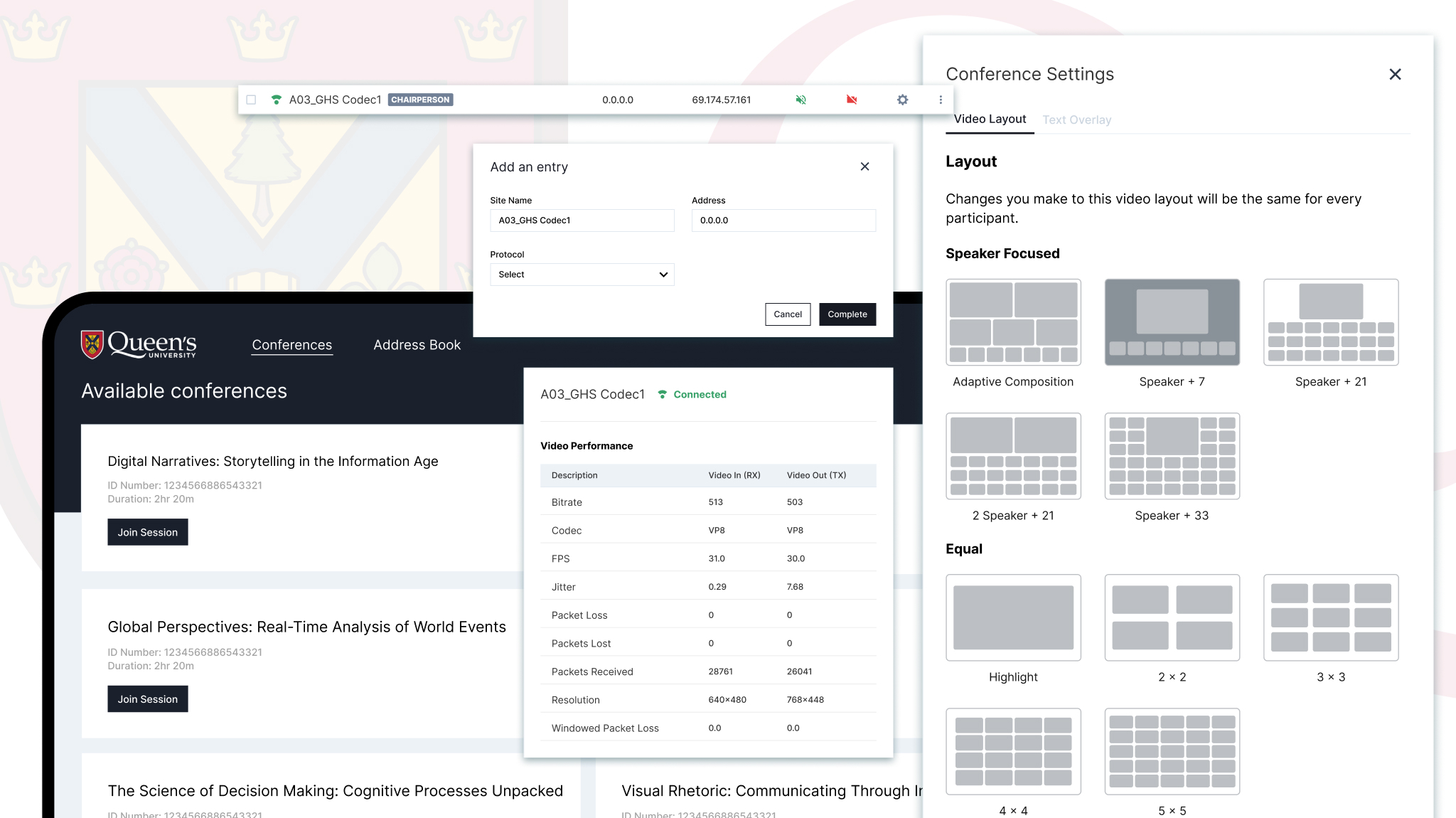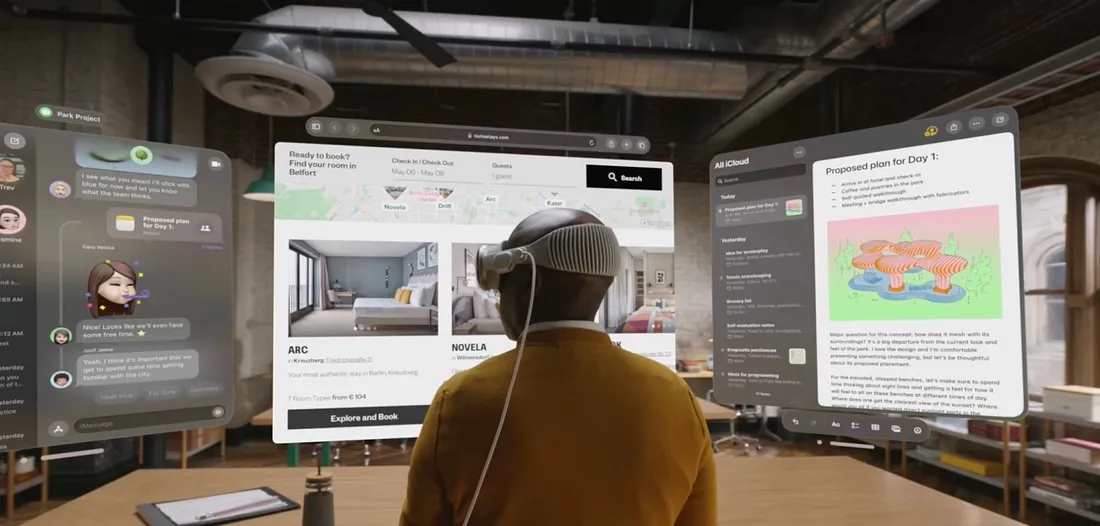

Escaping Legacy Tech: How HFC Designed a Custom Virtual Classroom Solution for Queen’s University
Queen's University
Queen's University needed a modern solution to manage its virtual classroom experience, a critical tool for conducting remote learning across geographically dispersed campuses. Their legacy video conferencing system, based on Polycom RX, was aging and no longer meeting their growing needs for usability, flexibility, and security.
Pexip, the video conferencing technology partner that handles the backend of these calls, introduced HFC to build a new front-end interface from scratch, one that could integrate with Pexip while it would continue handling the backend infrastructure for video conferencing. This meant the front-end could be fully custom, but it had to interact cleanly with Pexip’s architecture.
The challenge
When Queen’s University engaged HFC, they faced multiple challenges—technical, organizational, and timeline-related—that were all intertwined.
The initial discovery process revealed a massive list of highly specific requirements, stemming from the team’s unique workflows and the specialized roles involved in each call. For example, this new system needed to support secure logins, curated call lists, dynamic screen displays, and strict controls over who could speak, when, and how participants were displayed. On top of that, legal considerations around intellectual property and participant rights required rigor in both the interface’s design and backend data handling.
An outdated system
Their existing Polycom RX setup was inflexible, hard to use, and increasingly unsupported. Queen's needed a completely new interface that could support complex roles and user flows, such as customizing speaker layouts, managing participants, and enforcing strict communications protocols.
Updated requirements to meet real needs
The initial requirements were shaped at a strategic level, but as the project progressed and the team engaged more directly with classroom operators, it became clear that their day-to-day needs called for a different focus. The solution needed to align more closely with real-world workflows and user expectations.
Tight timeline and budget
With a fixed budget and limited time, the project had to be scoped and delivered as a minimal viable product (MVP), with ongoing iterative improvements.
Third-party API complexity
While Pexip’s APIs offered very robust capabilities, their integration required close coordination due to certain variables in documentation and behavior. Through ongoing collaboration and HFC’s deep technical expertise that enabled them to create solutions out of an otherwise bespoke environment, HFC worked through these challenges.
Queen's University chose HFC to help them:
- Design and build a user-friendly, operator-focused front end that minimizes complexity
- Create a lightweight MVP that delivered immediate value while allowing for future enhancements
- Navigate ambiguous and evolving requirements by staying close to operators and iterating quickly
- Implement a secure, self-hosted deployment architecture for Queen's’ network environment
The approach
HFC’s success with Queen's and Pexip was rooted in its collaborative, flexible, and technically robust process.
Starting with proof of concept
The engagement began with a proof of concept to demonstrate feasibility—deployed internally by HFC to validate integration with Pexip. This early validation was instrumental in gaining trust from both Pexip and Queen's, setting the stage for a fast-moving development process.
Iterative development and continuous feedback
With the MVP scope aligned, HFC prioritized must-have features by working directly with the operators—the people who would be using the system every day. Out of an initial list of nearly a hundred potential functionalities, roughly 30 core elements, including conference video capabilities and call operator controls, were selected for the first release. This helped reduce noise and focus on delivering value quickly.
Through weekly check-ins, the team was able to continue moving and adapting quickly, uncovering gaps in the original requirements and identifying high-impact features to replace lower-priority tasks. This allowed the team to seamlessly reallocate efforts toward what truly mattered to end users.
The platform was built using Next.js, which offered both performance and flexibility for rapid development. For lightweight, local data handling, HFC chose to use SQLite, which simplified state management without adding unnecessary infrastructure complexity. This streamlined stack supported a fast MVP turnaround while remaining easy to maintain and iterate on.
Designing for usability and control
The custom interface enabled operators to manage virtual classrooms easily—switching layouts, highlighting speakers, and moving participants across breakout rooms. HFC also introduced proactive alerting features that surfaced call quality issues to operators in real-time, replacing the need for them to manually sift through logs or dashboards.
Overcoming technical hurdles
One of the key technical challenges involved working with Pexip’s APIs, which required close collaboration due to limited documentation and variations across environments. This close collaboration with real-time communication enabled both teams to align quickly, troubleshoot efficiently, and ultimately build a stable foundation for the integration.
Secure and automated deployment
Because Queen's required the platform to be hosted on their internal network for compliance and security, HFC implemented a custom Ansible-based DevOps setup. This allowed for automatic deployment from GitHub to Queen's’ Red Hat Enterprise Linux (RHEL) servers, with minimal manual intervention and full control over the hosting environment.
The results
- A tailored MVP delivered on time: HFC launched a fully functional MVP empowering operators with the tools they needed while laying the groundwork for future features.
- Improved usability and operational control: The new interface reduced operator training needs and increased efficiency. Features like real-time alerts and simplified conference management dramatically improved usability compared to the existing Polycom interface.
- Reliable, secure deployment: The platform runs securely on Queen's’ own servers, meeting strict internal IT and privacy requirements.
The collaboration between HFC and Queen’s has not only overcome significant technical and operational hurdles but also laid the groundwork for a scalable, adaptable platform. The success of this project has already sparked interest from other major institutions—Cornell University, has also adopted this video conferencing platform, validating its utility and scalability in a broader academic context.
This cross-institutional traction highlights not only the solution’s versatility, but also a growing momentum across higher education for adopting new technology. The HFC team continues to work with Queen’s and support ongoing maintenance and incremental improvements, with regular updates driven by operator feedback.
Whether you're modernizing legacy systems or building from the ground up, HFC can help you deliver intuitive, secure, and scalable solutions—on time and on budget. Let’s talk about your project
Web
User Experience Design
Embedded Teams
Custom UI for usability and control
From Our Blog
The case for Vision Pro’s success — and the need for more thoughtful app design in a world of immersive tech
Last week, Apple announced the Vision Pro — the long-rumored mixed reality headset that had been gestating since the mid-2010s...
Learn More
Let's build something amazing
When you reach out to us, our senior staff are here to help learn more about your needs and hand-pick a team that you'll love.
